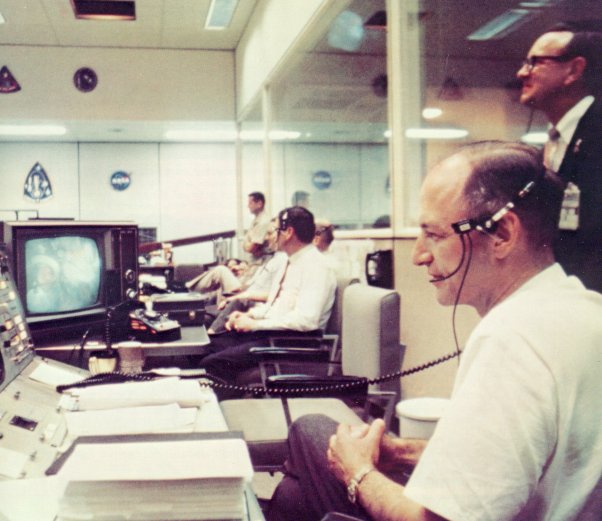Apollo Expeditions to the Moon
FLAWLESS RENDEZVOUS
The rendezvous was flawless. It began with the usual
maneuvering by the LM, using its reaction control system. Young,
in the command module, nominally had nothing to do except to wait
passively for the docking; the lunar module was expected to be
the active seeker and mover in the rendezvous. But in fact he had
to be prepared to take over the rendezvous if anything failed on
the LM. So he checked the rendezvous every step of the way with
sextant observations and ranging with very-high-frequency radio,
working out the things he would have to do in the event of a
lunar module system failure. The terminal phase of the docking
began an hour later, and the lunar module nudged its way into the
locking mechanism of the command module. The jubilant crews met
back in the command module.
| | |
Glistening in the sunlight, reflecting the Moon in
bright metal as yet undarkened by the savage
heat of atmospheric reentry, the Apollo 10
command module ghosts silently within a few yards
of its lunar module, occupied by Gene Cernan
and Tom Stafford. John Young is alone in the
command module at this point. The background
is the far side of the Moon, about 60 miles down.
|
For the final day in lunar orbit, Stafford, Young, and
Cernan spent their time in a series of experiments that would add
to the general fund of Apollo knowledge. They tracked landmarks.
worked on alignment exercises for the inertial platform, and took
a series of stereo-pair and sequence photographs of the lunar
surface, singling out features that would guide future
landing-site selections. And then it was time for the return to
Earth.
They fired the service module engine once again to move out
of the lunar orbit and back onto a trajectory toward the Earth,
using a fast-return flight path that would bring them back again
in 54 hours. The flight path again was established with great
precision; the only midcourse correction needed was done just
about three hours before the reentry, and it changed the velocity
by slightly more than two feet per second, or about one part in
20,000.
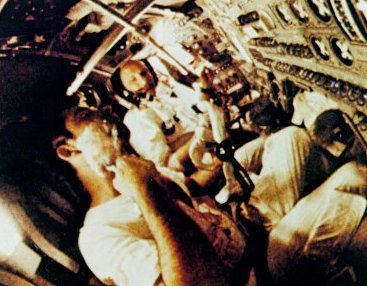
|
Shaving in space, expected to be a
problem (neither astronauts nor delicate
mechanism would thrive in a whiskery
atmosphere), proved to be no problem at
all with an adequately sticky lather. Looking
on is Apollo 10 Commander Stafford.
|
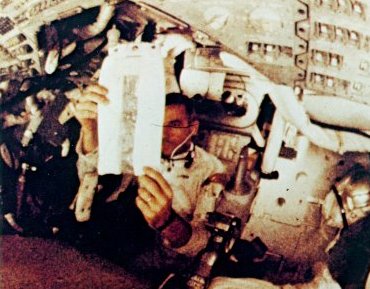
|
A meal, not a map, is what Gene Cernan
is holding up here. It's a plastic envelope
containing a chicken and vegetabie mix;
und with hot water added it made a
palatable main course. In the Mercury
days space food had been almost as
grim as Army survival rations, but during
Apollo the eating grew a lot better.
By the end of the program, individual
astronaut preferences were reflected in
the flight menus, and spooned dishes and
sandwich spreads were available.
|
Fifteen minutes before reentry, they separated the command
module from the service module. The command module bearing the
crew streaked through the atmosphere; the parachutes deployed and
let the spacecraft down on their target coordinates. The
astronauts always made much of the accuracy of their landings,
with a pool going to the crew landing closest to the target. (In
fact, the navigation and guidance accuracy was such that the
spacecraft computers pinpointed the target location better than
the recovery ships were able to. Later, ships used inertial
navigation that was as accurate as that in the spacecraft, but
their captains stood off by a mile or two from the landing point
to avoid any possibility of a collision.) Navy helicopters swung
over their rafts, lifted the crew and took them back to the
recovery carrier, the USS Princeton, within 39 minutes after the
craft had hit the water. About an hour later, the spacecraft
itself was hoisted. charred and dripping, onto the deck of the
Princeton.
| | |
Manning his control console in the Mission Control Center in Houston
is George M. Low, then Apollo Spacecraft Program Manager.
Behind him is Chris Kraft, Director of Flight Operations at the
Manned Spacecraft Center. They and the other men in the photo
are viewing a color television transmission from the Apollo 10
during the second day of ist lunar orbit mission. The spacecraft at this
point was some 112,000 miles from the Earth, about halfway to
the Moon. Low's TV monitor is off to the left.
|
These two flights had been successful; more, they had been
nearly trouble-free. The confidence they gave to the planned
Apollo 11 mission was almost tangible, erasing any doubts about
the pace and the direction of the program before Apollo 9 and 10.
The thoroughness of the approach, the critical design reviews,
and the extensive test and simulation work on the ground had
successfully demonstrated the readiness of equipment and crews
for the next step.
| | |
Dawn was just breaking as Apollo 10 gently floated down into the Pacific 395 miles east
of Pago Pago. The pinpoint landing was so accurate that the blinking tracking lights on the
spacecraft were visible from the USS Princeton during the descent.
|
Everything had been done that would later be done by the
crew of Apollo 11, except for the actual touching down on the
Moon's surface, the stay there, and the liftoff. Apollo 9 and 10
had done all they could to prepare the entire team- astronauts,
flight controllers, ground-support personnel, and management - for
the great adventure.

|
Flotation collar secured, frogmen get ready to assist
the Apollo 10 astronauts from the command module.
Named Charlie Brown, the CM landed three and a half
miles from the USS Princeton. About one-half hour later
the astronauts were aboard the recovery ship, having
spent eight days in space.
|
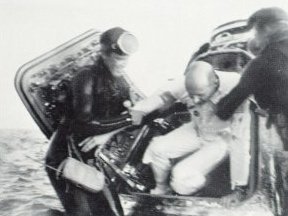
|
Returning from the dress rehearsal, Commander
Thomas P. Stafford is aided from the command module
by frogmen. By demonstrating lunar orbit rendezvous
and the LM descent system, this lunar orbit mission set
the stage for Apollo 11, which flew two months later
and put men on the Moon.
|
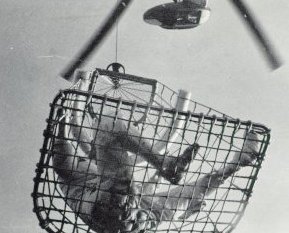
|
Hoist away! Shortly after they come down from space,
the astronauts go back up; this time only briefly as the
cage and sling carry them one at a time to the recovery
helicopter hovering above (the camera freezes two of
its blades).
|
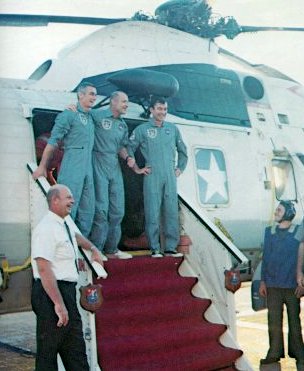
|
Glad to be home. Standing in the copter doorway
the jubilant Apollo 10 crew smile at well-wishers
aboard the Princeton. From left: LM Pilot Gene Cernan,
Commander Tom Stafford, and CM Pilot John Young.
The Apollo 10 splashdown was near American Samoa.
|
|




